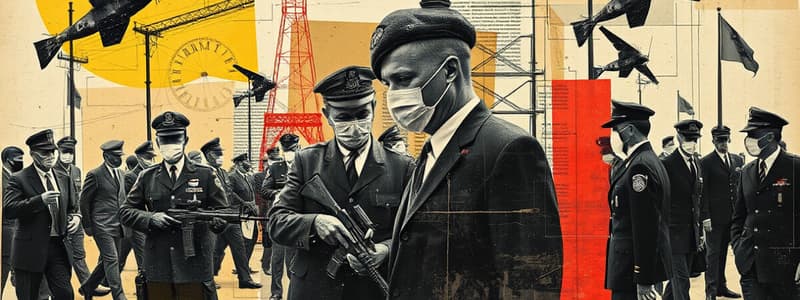Podcast
Questions and Answers
What is the primary purpose of the Tactical Withdrawal policy?
What is the primary purpose of the Tactical Withdrawal policy?
- To manage financial records
- To enhance public relations
- To establish guidelines for tactical withdrawals from any scene or location when confronted by violent individuals or threatening situations (correct)
- To streamline fire response operations
What is the policy regarding the actions of COMM Fire Department members when facing threats?
What is the policy regarding the actions of COMM Fire Department members when facing threats?
- Members should never withdraw from the scene
- Members can withdraw only after receiving approval from the Fire Chief
- Members are allowed to withdraw from the scene when confronted by violent individuals or situations presenting a real or perceived imminent threat to member safety (correct)
- Members must always remain at the scene regardless of threat
What should members of the department continually assess while responding to incidents?
What should members of the department continually assess while responding to incidents?
- Public relations opportunities
- Their surroundings and the actions and conduct of persons at an event (correct)
- Training schedules
- Financial records
Which situation necessitates increased awareness regarding personnel safety?
Which situation necessitates increased awareness regarding personnel safety?
Who is authorized to initiate a tactical withdrawal?
Who is authorized to initiate a tactical withdrawal?
What action should be taken if a credible threat to personnel is identified above the on-scene supervisor?
What action should be taken if a credible threat to personnel is identified above the on-scene supervisor?
In a threatening situation, when is it appropriate for a member to consider withdrawing from an incident?
In a threatening situation, when is it appropriate for a member to consider withdrawing from an incident?
What factor should not influence the decision-making of members during an incident?
What factor should not influence the decision-making of members during an incident?
What should be established at a safe location during a tactical withdrawal?
What should be established at a safe location during a tactical withdrawal?
Who is responsible for personnel accountability during a tactical withdrawal?
Who is responsible for personnel accountability during a tactical withdrawal?
What should Dispatch do immediately after a tactical withdrawal is initiated?
What should Dispatch do immediately after a tactical withdrawal is initiated?
What is the primary responsibility of the Incident Commander during a tactical withdrawal?
What is the primary responsibility of the Incident Commander during a tactical withdrawal?
What should individual unit supervisors do after all units have been initially notified of a tactical withdrawal?
What should individual unit supervisors do after all units have been initially notified of a tactical withdrawal?
Who is responsible for ensuring all Division Fire Suppression Division personnel are notified of a tactical withdrawal incident?
Who is responsible for ensuring all Division Fire Suppression Division personnel are notified of a tactical withdrawal incident?
What should be done if violence forces members to abandon a patient under their care?
What should be done if violence forces members to abandon a patient under their care?
Once all units have withdrawn from an incident, what report should be conducted?
Once all units have withdrawn from an incident, what report should be conducted?
What should be done with patients during a tactical withdrawal if possible?
What should be done with patients during a tactical withdrawal if possible?
What must be done whenever a tactical withdrawal is initiated?
What must be done whenever a tactical withdrawal is initiated?
When should a tactical withdrawal be initiated?
When should a tactical withdrawal be initiated?
What special consideration should be taken during a tactical withdrawal involving medical assessment or care?
What special consideration should be taken during a tactical withdrawal involving medical assessment or care?
What should the IC or scene supervisor do after all involved units have gathered at the staging area during a tactical withdrawal?
What should the IC or scene supervisor do after all involved units have gathered at the staging area during a tactical withdrawal?
What should the Duty Officer coordinate with Dispatch and law enforcement?
What should the Duty Officer coordinate with Dispatch and law enforcement?
Flashcards are hidden until you start studying
Study Notes
Tactical Withdrawal Policy Overview
- The primary purpose is to establish guidelines for tactical withdrawals when faced with violent individuals or threatening situations, ensuring member safety.
- Members are permitted to withdraw if confronted by real or perceived threats to their safety, rather than remaining at the scene.
Personnel Awareness and Evaluation
- Continuous evaluation of surroundings and conduct of individuals at incidents is crucial; heightened awareness is mandatory during gang-related activities involving violence.
Authority and Initiation of Withdrawal
- Tactical withdrawals can be initiated by the Incident Commander (IC), scene supervisor, or a senior member on the scene, emphasizing the importance of leadership in crisis situations.
- Any credible threats identified must be communicated down the chain of command, potentially resulting in a tactical withdrawal order.
Communication and Accountability
- The initiating member of a withdrawal must notify all responding units and Dispatch about the withdrawal action.
- A defined staging area should be established away from the incident for safety and accountability during tactical withdrawals.
Role of Dispatch and Post-Withdrawal Procedures
- Dispatch is responsible for notifying and requesting immediate law enforcement assistance for securing withdrawing units.
- Upon confirmation of withdrawal, a Personnel Accountability Report (PAR) must be conducted to ensure everyone is accounted for.
Patient Care Considerations
- During tactical withdrawals, efforts should be made to maintain care and evacuate medical patients whenever possible.
- If violence necessitates abandoning a patient, law enforcement should be notified of the patient's location for assistance.
Aftermath of the Withdrawal
- Once law enforcement clears the area, members should locate patients to resume care as per protocols.
- Notifications of the withdrawal circumstances must be relayed up the chain of command to maintain clear communication.
Coordination and Safety Measures
- The Duty Officer must coordinate with Dispatch and law enforcement to screen additional calls for safety.
- Unaccounted personnel post-withdrawal will trigger emergency procedures to ensure safety.
General Policy Points
- The policy for tactical withdrawal is designated as Policy 305.
- Responsibilities are assigned to ensure accountability among individual unit supervisors and other personnel during tactical operations, focusing on safety and communication.
Studying That Suits You
Use AI to generate personalized quizzes and flashcards to suit your learning preferences.




